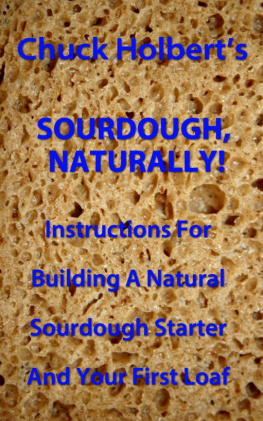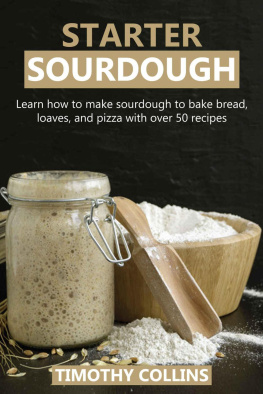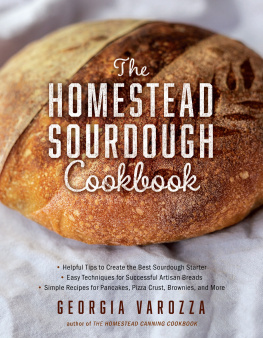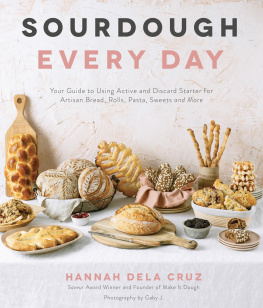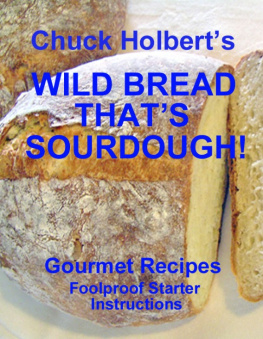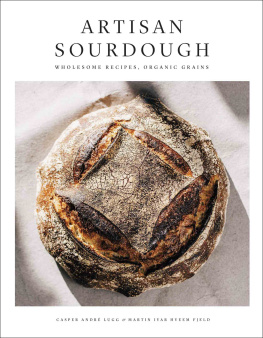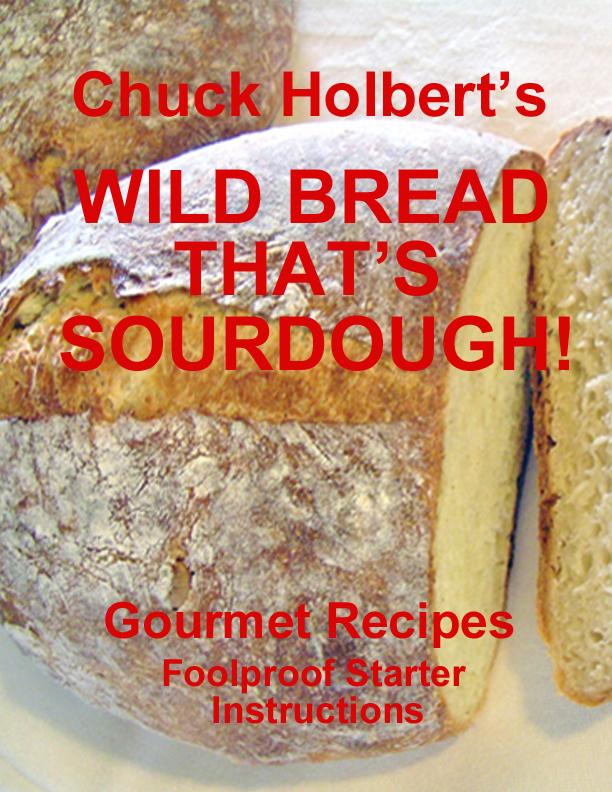
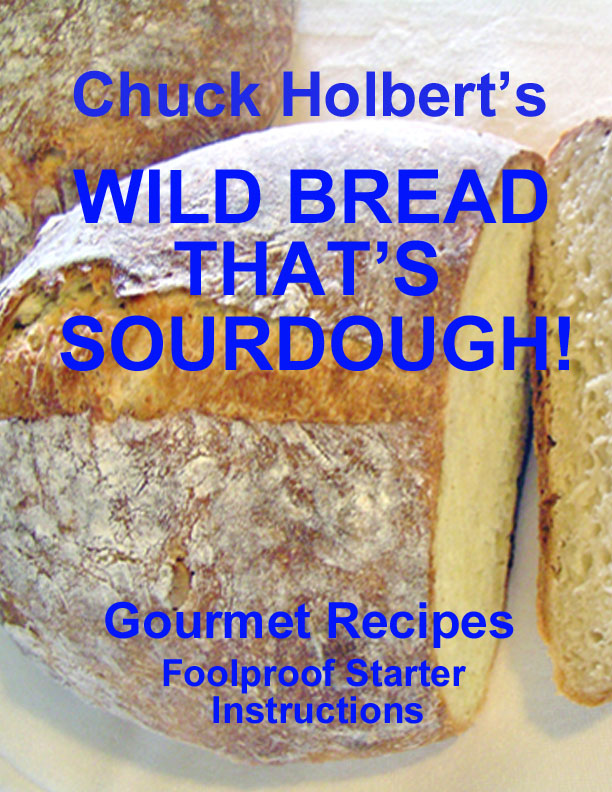
CHUCKHOLBERT'S
SOURDOUGH ,NATURALLY!
Smashwords Edition
Copyright 2010Chuck Holbert
LicenseNotes
This e-book is licensed for your personalenjoyment only. This e-book may not be re-sold or given away toother people. If you would like to share this book with anotherperson, please purchase an additional copy for each recipient. Ifyou are reading this book and did not purchase it, or it was notpurchased for your use only, then please go to Smashwords.com andpurchase your own copy. Thank you for respecting the hard work ofthis author.
Quotations less than a paragraph in lengthmay be used without permission in reviews or articles. Forpermission for longer quotations, please contact the author atwww.wildediblerecipes.com.
Foreword
I am offering this free copy on how todevelop a true sourdough starter to share my discovery of a bettermethod in a rather obscure scientific publication about ten yearsago. Once you have used this method and if you are pleased, I hopeyou choose to reward me by buying my e-book "Wild Bread - That'sSourdough!" containing dozens of well tested sourdough recipes.
Making sourdough once was a complicatedprocess, up to twelve tricky steps and many days. No wonder it fellfrom favor in our high-speed industrial societies. However, withour new scientific understanding of sourdough you can produce anartisan sourdough loaf with less than 30 minutes active time in thekitchen, after you have developed a starter.
The main secret of high quality artisansourdough is in the starter, a truly wild one based on solidscience. Other secrets are the use of natural ingredients,extensive use of parchment for ease of handling soft dough, theslow low temperature development of the dough allowing themicroorganisms and enzymes naturally present in the flour to dotheir work and last of all baking in a Dutch oven to best duplicatethe conditions in a French steam oven.
Wild Yeast (Saccharomyces exiguus) is amember of the Fungi Kingdom and it is wild everywhere. It is evenfound in the stratosphere. While not a mushroom, it is a closecousin. This specific yeast is the catalyst for creating anenvironment suitable for the enzymes and specific bacteria neededto make truly artisan sourdough bread.
When wheat flour and water are mixed, threebiological processes start; enzymes, bacteria and yeast startworking on the various molecules that make up the flour and thebyproducts from the biological activity of the other organisms.These three things (enzymes, bacteria, yeast), are always naturallypresent with the living wheat plant, in fact, virtually all thingsalive, including humans. The bacteria and enzymes give sourdoughbread its characteristic flavor, while the yeast provides thecarbon dioxide that causes the bread to rise and become tender.
Last, and perhaps best, after your initialinvestment in cooking supplies you may not already have and alittle hunting out local resources, your artisan sourdough loaveswill cost less than a dollar.
Chuck Holbert, 2010
Coos Bay, Oregon
The Case For NaturalFoods
True sourdough, is a fermented wild food.Fermented foods using similar wild cultures were a major part ofour diet, but their significance in nutrition was much larger. Someof these are cheese, yogurt, kefir, sour cream, buttermilk, soysauce, Tabasco sauce, miso, sauerkraut, pickles, kim-chi, olives,mushrooms, cocoa, tea, cider, beer, wine, whiskey, vinegar,chorizo, salami and fish. Fermented fish did you say? Yes,fermented fish is present in the cuisine of more than two-dozeninternational cultures. Do you remember Worcestershire sauce (readthe ingredients), pickled herring or caviar?
Originally these were foods made using wildcultures to safely preserve them for later use, but they alsoproduced better digestion and resultant good health. The wildmicroorganisms that facilitated the transformation of these foodsbrought benefits not contained in the original raw food, but thiswas not understood until very recently.
Modern food manufacturing, driven by the needfor speed and consistency, virtually eliminated these wild naturalprocesses from our diet near the middle of the last century.Natural processes took a long time, were not predictable andrequired completely fresh food products. Most of the foods listedabove are making a significant return to the market as consumersare discovering the superior taste and health benefits of naturallyfermented foods.
Bread is the exception. The sourdough loaffound in your supermarket today is likely not wild and natural.That supermarket loaf is more likely produced with a processrequiring highly selective commercially cultured organisms,processed at high temperatures and using sterilized raw materials.Or worse, that loaf may just be common factory bread with chemicaladditives to make it feel and taste like sourdough.
Including wild natural sourdough breads inyour diet brings better nutrition. The wild sourdoughenzyme-bacteria-yeast synergism strips simple sugars, removesdamaged starches and unwanted metabolic byproducts from the dough,making sourdough the only bread recommended in a diabetic diet.
Natural sourdough is acid. This destroysmolds and discourages unfavorable bacteria. Also the synergisticorganisms grow great in numbers and thus create a host of vitamins(B1 through B6, B12, C and E) not found in the dough otherwise.
And last, the phytic acid normally present inmost grains interferes with essential mineral uptake in digestion.The wild sourdough synergism eliminates most of the phytic acidpresent in the flour.
Right Stuff
Water is the most important ingredient andshould always be filtered. Do not use distilled water or retailbottled water. Your refrigerator may already have an acceptablefilter on the drinking water dispenser. Check it out. If not, Britamakes an inexpensive filter pitcher that will do the job well.
Municipal water treatment chemicals,specifically the biocide chlorine and certain algaecides, willseriously affect your population of microorganisms essential tomaking quality sourdough. Your local water may have an excellentreputation and be clear, but most quality artisan bakeries haveextensive water treatment equipment in their facilities for thisvery reason.
It is important to notice here that water,rather than flour, is considered the primary ingredient in mymethod. I do not use the bakers math or gram weighing ofingredients or using flour as the primary ingredient. We will addflour slowly to the called amount of water and knead until thedough behaves as instructed. It is easier to add more flour laterif the dough is too wet, rather than more water if the dough is toostiff.
The flour you select will make or breakyour effort to develop a starter. I recommend that you startwith organic bread flour, organic all-purpose flour, organicwhole-wheat flour, organic rye flour or a combination of these.Stone ground is best because of the low temperature process and themicroorganisms present are not as affected.
It will, of course, be unbleached flour andthis is essential for improving your chances of developing a goodstarter. You may elect to not use organic once you have a goodstarter because of the expense, but in no case should you ever usebleached or bromated flour.
Whichever course you take, it is important tostay with the type of flour you choose during the learning stage.You may find this flour on your grocers shelf, in bulk at a foodcooperative or order it directly from one of the millers on theInternet. If you intend to try all the recipes here, you will needa small amount of rye and rice flour.
Next page
